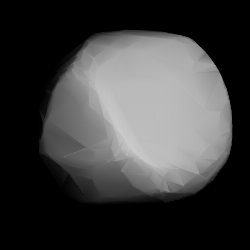Astronomy:195 Eurykleia
 3D convex shape model of 195 Eurykleia | |
| Discovery | |
|---|---|
| Discovered by | J. Palisa, 1879 |
| Discovery date | 19 April 1879 |
| Designations | |
| (195) Eurykleia | |
| Pronunciation | /jʊrɪˈkliːə/[1] |
| A879 HA; 1949 QB2 | |
| Minor planet category | Main belt |
| Orbital characteristics[2] | |
| Epoch 31 July 2016 (JD 2457600.5) | |
| Uncertainty parameter 0 | |
| Observation arc | 131.99 yr (48,208 d) |
| |{{{apsis}}}|helion}} | 3.00 astronomical unit|AU (449.33 Gm) |
| |{{{apsis}}}|helion}} | 2.75 AU (411.29 Gm) |
| 2.88 AU (430.30 Gm) | |
| Eccentricity | 0.044205 |
| Orbital period | 4.88 yr (1,781.9 d) |
| Mean anomaly | 113.56° |
| Mean motion | 0° 12m 7.308s / day |
| Inclination | 6.9718° |
| Longitude of ascending node | 6.9930° |
| 119.12° | |
| Earth MOID | 1.77 AU (264.87 Gm) |
| Jupiter MOID | 2.01 AU (300.95 Gm) |
| TJupiter | 3.284 |
| Physical characteristics | |
| Mean radius | 42.855±0.85 km |
| Rotation period | 16.52178±0.00001 h[3] |
| Geometric albedo | 0.0599±0.002 |
| Ch[3] | |
| Absolute magnitude (H) | 9.01 |
Eurykleia (minor planet designation: 195 Eurykleia) is a fairly large main belt asteroid. It was discovered by the Austrian astronomer Johann Palisa on April 19, 1879, and named after Euryclea, the wet-nurse of Odysseus in The Odyssey.
This body is orbiting the Sun with a period of 4.88 years and a low eccentricity (ovalness) of 0.04. The orbital plane is inclined by 7° from the plane of the ecliptic. It is spinning with a rotation period of 16.5 hours and varies in brightness with an amplitude of 0.24 magnitude. The cross-section diameter of this body is 43 km. The asteroid has a taxonomic type of Ch in the SMASS classification,[3] which indicates it has a dark surface with a primitive carbonaceous composition.
195 Eurykleia has been observed to occult stars twice, once in 2011 and again in 2021.
References
- ↑ "Euryclea". Dictionary.com Unabridged. Random House. https://www.dictionary.com/browse/Euryclea.
- ↑ "195 Eurykleia". JPL Small-Body Database. NASA/Jet Propulsion Laboratory. https://ssd.jpl.nasa.gov/sbdb.cgi?sstr=195;cad=1.
- ↑ 3.0 3.1 3.2 Marciniak, A. et al. (May 2019). "Thermal properties of slowly rotating asteroids: results from a targeted survey". Astronomy & Astrophysics 625: 40. doi:10.1051/0004-6361/201935129. A139. Bibcode: 2019A&A...625A.139M.
External links
- 195 Eurykleia at AstDyS-2, Asteroids—Dynamic Site
- 195 Eurykleia at the JPL Small-Body Database
 |

